TO CLAIM A FIND FOR THIS EARTHCACHE
1) Complete the “conclusion” for this cache description.
2) Answer the questions below regarding the “reference fossil” at S33o 20.421; E19o 32.605 (NB: this is ~30m from GZ and refers to a SPECIFIC "fossil" you have to find).
a) What type of “fossil” is it? (body, trace or chemical)
b) Calculate the absolute age of the “fossil”.
c) Would you expect to find this “fossil” here? Why/why not?
(Refer to succession and the absolute age of the “fossil” in your answer.)
Note: Please e-mail your answers to 1 & 2 to the cache owner.
3) Optional: Share your experience with the caching community by uploading photos of the fossils you’ve found and/or avid caching palaeontologists at GZ with your log.. |
INTRODUCTION
An earth cache that will give you an opportunity to scratch around Bokkeveld mudstone and shale in a quarry on a mountain top and discover traces of prehistoric life, entombed in the muddy depths of a ancient sea 400 million years ago! To really enjoy this earth cache you have to put some time aside to search for fossils yourself. So take a hammer with, walk around and break open a few of the rocks dug up by the bulldozers and see if you can find a fossil, it’s much easier than what you might expect, it’s exhilarating and it’s addictive!
Notes:
1. There are more fossils in the light coloured (greyish) mudstone close to the surface (i.e. in the shallow excavations).
2. We’ve placed a few fossils next to the protea bush closest to GZ for you to see what the fossils look like.
3. All fossils in South Africa are protected by the National Heritage Resources Act (Act 25 of 1999), which prohibits without a permit, the destruction, damage, excavation, removal or collection of any paleontological material or object, so please do not remove any fossils from the site.
FOSSILS 101
What is a fossil?
A fossil is a physical trace of past life. It does not only include the actual remains of living organisms (i.e. body fossils such as teeth, bones, shells or leaves), but also the signs of their activities (i.e. trace fossils such as burrows, foot prints or faeces) and organic compounds produced from ancient living organisms (i.e. chemical fossils such as oil, natural gas and coal). The oldest fossils on earth are those of blue-green algae mats that lived over three billion years ago.
How are fossils formed?
The term 'fossilisation' refers to a variety of often complex processes that enable the preservation of organic remains within the geological record. It often occurs as a result of rapid burial, usually by water-borne sediment, followed by chemical alteration. Decomposition, sediment deposition, rock formation and erosion are processes that easily destroy soft tissue, so it is the hard parts of organisms such as shells, bones and teeth, which are most often preserved. Rapid burial in a fine clay matrix with a favourable chemical composition helps to reduce decomposition and supplies the required physical and chemical environment necessary for the slow chemical transformation of the organic material. Exceptional events/conditions, e.g. entombment in a chemical matrix such as tree resin (amber) or tar, may also help to preserve soft tissue or impression of soft body parts. The sequence of events leading to the fossilisation of organic material and the subsequent discovery of the fossil is summarised in the diagram below (Fig 1).

Figure 1. Visual representation of the sequence of events leading to the fossilisation of organic material and the subsequent discovery of the fossil. (i) Death of the organism, (ii) decay of soft tissues and burial, (iii) sediment deposition and fossilisation, (iv) uplift, erosion and exposure and (v) discovery and extraction.
How is the organic material or traces actually preserved?
The preservation/transformation of organic material or a trace, which is required to produce a fossil, occurs through one of the following mechanisms:
(i) Permineralisation is the process whereby ground water, containing dissolved minerals, infiltrates the microscopic pores and cavities in bone, wood or shell and the minerals are deposited in the cavities as crystals. This process continues until all the cavities are completely filled, resulting in a stony fossil that still contains a good deal of its original solid, organic material. In summary, during permineralisation organic material is filled with minerals and not completely replaced. On the other hand, if the process continues to also replace the original organic material (e.g. cellulose) with minerals (e.g. silica compounds) it is called petrification. Because these lithification (“becoming rock”) processes happen on a molecular level the details of the original structure is conserved and the resulting “rock” can be identified as a fossil.
(ii) Carbonisation is the process by which the more volatile substances of plants and animals decay, but leave behind the carbon. If it gets covered in silt and subjected to heat and pressure, most of the organism's organic material is released as methane, water and carbon dioxide. The remainder is a thin film of carbon, showing the imprint of the organism. Fairly flat organs or organisms, e.g. leaves, insects and fishes can be preserved in this way.
(iii) The remains of organisms which have been preserved through freezing (in permafrost areas), desiccation (in deserts) or in chemicals (tree resin or tar) could also survive as unaltered fossils. Preservation in this case is dependent on local climatic conditions and such fossils are unlikely to survive any significant amount of geological time, they are therefore rare and never very old.
(iv) Moulds or casts. If the sediment surrounding an organism becomes firm (lithified) and the organism dissolves away thereafter, it will form a cavity in the form of the organism, i.e. a mould (duplicating the original outer surface of the organism). Similarly, casts form when sand or clay fills hollow things such as empty shells of snails and clams and become lithified before the organic structure disappears (duplicating the original inner surface of the organism).
How do you determine the age of a fossil?
The relative age (also called comparative age) of a fossil is determined by its position relative to other fossils in different rock strata. Because sedimentary strata are deposited sequentially the top layers are younger than the bottom ones and you can therefore determine which fossils are oldest based on their relative position in the different rock strata. The absolute age of a fossil (in number of years) can be calculated using radioisotope dating.
Briefly: A radioisotope is an unstable form of a particular element that decays at a very specific rate (i.e. its half-life = time needed for half of the radioisotope to decay) to form a different element, e.g. Uranium-235 (235U) decays to yield Lead-207 (207Pb) with a half-life of 700 million years. Determining the ratio between 207Pb and 235U in a rock will therefore give you an indication of the age of the rock.
Example: For a rock with a Pb:U ratio of 4:5 follows: 4/5 x 700 million years = 560 million years old.
Note: Carbon-14 dating, often used for organic compounds, can only be used for artefacts between 1,000 and 65,000 years old because of carbon-14’s relative short half-life of 5,730 years.
FOSSILS & GEOLOGY
What is the link between fossils and geology?
Because the fossil-forming remains of an organism are rapidly entombed in sediment, the resulting sedimentary rock stratum in which the fossil is located can be associated with a very specific time interval in geological history. From this follows the principle of faunal succession, i.e. sedimentary rock strata contain fossils that succeed each other vertically in a specific, reliable order (younger fossils towards the top) across wide horizontal distances (Fig 2). As organisms exist during the same time period throughout the world, their presence may therefore be used to provide a relative age for the formations in which they are found – this is especially valuable when the formations have been subjected to folding and/or faults and the original succession sequence is not that clear. Fossils therefore provide a link between geology and biology that is valuable to the study of global changes and how life adapts to this.

Figure 2. The Cape-Karoo succession and its associated fossils.
How did marine fossils end up here in the mountains?
Approximately 400 million years ago (MYA) further extension of the Cape Trough rift lead to the deepening of the Agulhas Sea, bringing about the deposition of deep-water, fine grained sediments (Fig 3A). Dead marine organisms of the time were entombed in these sediments and fossilised as the sediments lithified to form mudstone and shale in what we today known as the Bokkeveld Group.
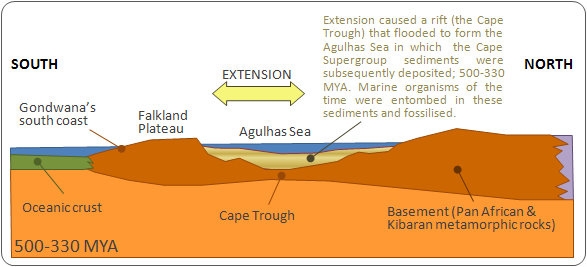
Figure 3A. South-North cross section of Gondwana 500-330 MYA showing the Agulhas Sea in which the Cape Supergroup sediments, including the Bokkeveld group, were deposited.
Seventy million years later (~330 MYA) the Cape Trough extension ceased as a subduction zone developed along the southern margin of Gondwana (Fig 3B). This resulted in the northerly compression of the landmass which caused the thickening of the crust and the rise of a mountain range (the Cape Fold Mountains) where formerly a sea had existed – a range composed of sedimentary rocks previously deposited on the floor of the Agulhas Sea.
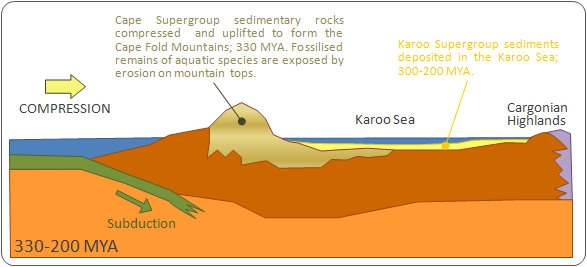
Figure 3B. North-South cross section of Gondwana 330-200 MYA showing the formation of the Cape Fold Mountains consisting of uplifted Cape Supergroup sedimentary rocks.
In contrast to the coarser, underlying Table Mountain and overlaying Witteberg Group sandstones the Bokkeveld sediments were converted to mudstone and shale which preserve fossils relatively well. The bulk of the well-known invertebrate fossils of the Cape Supergroup are then also found within these fine-grained Bokkeveld rocks.
What fossils can you expect to find here?
The Bokkeveld sediments were deposited in the Agulhas Sea during the early to mid Devonian period (415-390 MYA) implying that you should find fossils of marine animals from that period in these rocks. The most abundant fossils and therefore the ones you’re most likely to find include…
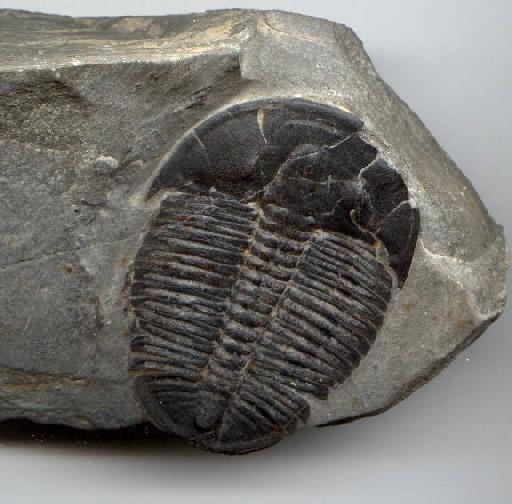
1. Trilobites were hard-shelled, segmented creatures that lived in the world’s ancient seas and are one of the key index creatures of the Paleozoic Era (543-248 MYA). The name “trilobite” means “three lobed" and is derived from the fact that these animals had bodies featuring three longitudinal lobes, not lateral (head, body, tail) as many modern Arthropods. The most common fossils of trilobites are the mineralised dorsal (upper) exoskeleton of the creature; the tail plate is especially abundant here (see background photo).
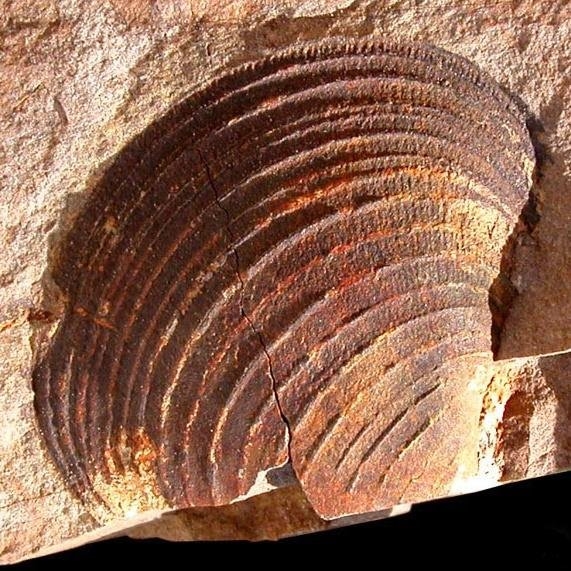
2. Brachiopods (lampshells) and bivalves (e.g. mussels and clams). Brachiopods and bivalves are bottom dwelling, soft bodied, marine animals which live within two valves (shells). The two shells of a brachiopod are usually symmetrical about the midline but the two shells are not equal to each other (both in shape and size). In contrast bivalves (e.g. clams and mussels) are asymmetrical about the midline with each valve or shell equal mirror images of each other.
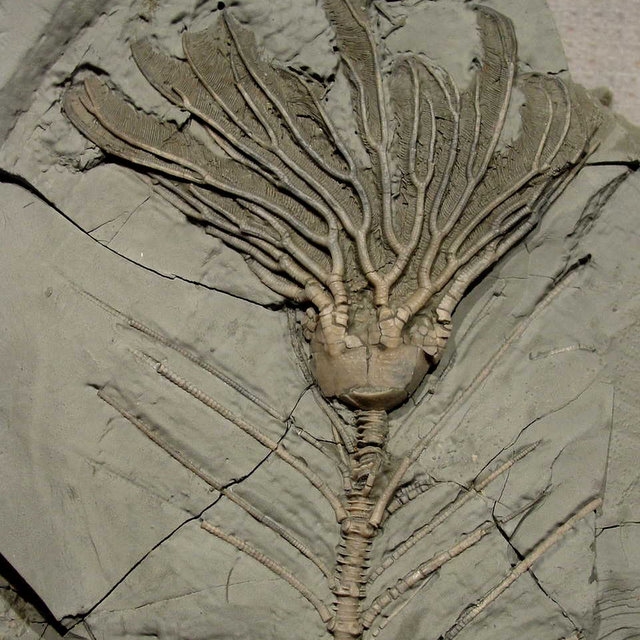
3. Crinoids are also referred to as feather stars or sea lilies due to their long stem and flower-like arms but they are in fact animals. They are related to starfishes, sea urchins and sand dollars and there are still some species alive today. Most crinoid fossils found are of the stem only as it is more resistant to decomposition and degradation than the delicate arms. Single stem segments resemble buttons when fossilised.
CONCLUSION
(…) are traces of past life which were preserved as one of three different fossil types, i.e. (…, … or …) fossils. The rapid burial of organic remains in a fine clay matrix with a favourable chemical composition helps to reduce (…) and supplies the required (…) and (…) environment necessary for the slow processes of fossilisation. One process whereby fossilisation occurs is the deposition of mineral crystals in the microscopic cavities in organic materials such as shell and bone and is called (…). The fact that sedimentary rock strata contain fossils that succeed each other vertically in a specific, reliable order is referred to as (… …) and from this the (…) age of fossils is determined. The Cape Supergroup sediments, including the fossil containing (…) group, were deposited in the (…) Sea. (…) MYA the development of a (…) zone on the southern edge of Gondwana caused compression and uplift which resulted in the formation of the (… …) Mountains and the exposure of these sedimentary rocks on a mountain top. You could expect to find fossils of the (…) period (~400 MYA) at GZ.
References
McCarthy T & Rubidge B (2005). The story of earth & life: A Southern African perspective on a 4.6-billion-year journey.
http://www.fossils-facts-and-finds.com
http://www.fossilmuseum.net
http://petrifiedwoodmuseum.org

Free counters
*******************************************
FTF:  and
and 